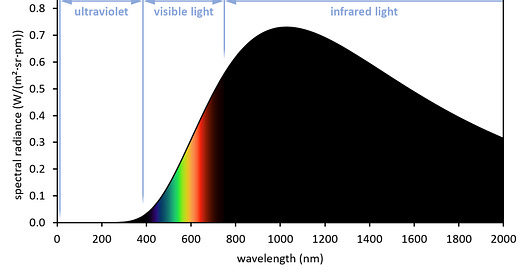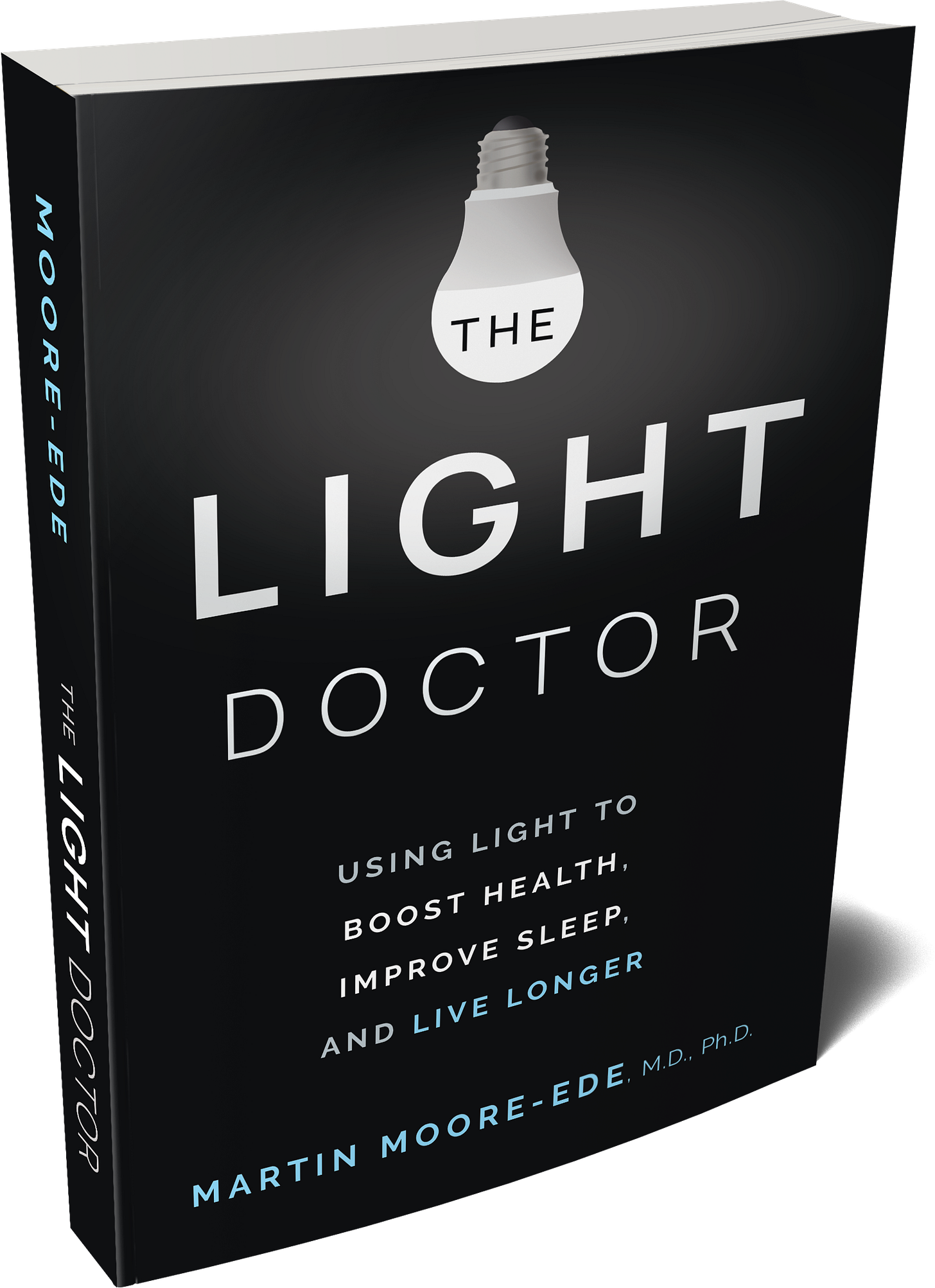What We Lost When the Incandescent Light Bulb was Banned: Infrared Light Producing Relaxation and Pleasure
Blue-rich LEDs induce a stress response that makes us miss the calming effect of incandescent light
Traditional incandescent light bulbs were banned in 2023 because they did not meet the US Department of Energy (DOE) 45 lumens per watt standard for light bulbs. Only 12% of the electrical energy they consumed produced visible light, the other 88% created invisible infrared wavelengths. They have now been replaced by blue-rich LED light bulbs which produce a narrow spectrum of visible light with no infrared.

This ban on incandescent light bulbs would seem to make sense if you believe the only function of a light bulb is to banish darkness and aid vision. However, we are now learning increasingly more about the critical health-promoting properties of infrared light on mitochondrial health, metabolism and healing. That will be the subject of a later Substack article. But today we will focus on the prevention of stress.
Infrared Light Produces Relaxation and Pleasure
A new study shows that invisible near-infrared light also calms down the sympathetic fight-or-flight response and induces a state of relaxation and pleasure.

Lights that emit near-infrared in the 800-1000 nm range were shown to increase heart rate variability, a marker of parasympathetic activity. This is part of our body’s autonomic control system which can either activate us in times of danger or challenge (sympathetic nervous system). or calm us down when we are safe and can relax. (parasympathetic nervous system). This autonomic nervous activity can be tracked objectively using an EKG because the sympathetic system makes the heart beat faster, but also more regularly, whereas the heart rate slows under the parasympathetic influence but also becomes slightly more irregular (i.e. the beat-to-beat interval is more variable).
To avoid any placebo effects the study used a simple cubicle with white overhead lights. The study volunteers could not tell whether or not a white LED light fixture was emitting near-infrared light in addition to the visible light, or whether they were just getting the white blue-rich LED light without any added infrared.

The research team, as reported by Roddick et al, in the Journal of Environmental Psychology1, showed the study volunteers had a significant decrease in heart rate variability, and an increased subjective sense of pleasure when the lights contained infrared wavelengths.
Blue-Rich LED lights produce a stress response
In contrast, the LED lights we are forced to use to meet the ever more stringent DOE energy standards are rich in blue, green, and yellow but deliver no ultraviolet or infrared. They are, therefore, missing many of the ingredients of natural outdoor light, which is rich in ultraviolet, all the visible colors of the light spectrum, and lots of infrared light.
The blue content of high CCT LEDs induces stress, and an alerting response. Heart rate variability, a measure of sympathetic nervous system activity, is increased by bright blue-rich light, and if blue-rich lights are used in the evening prior to bedtime, they generate a lingering unhelpful sympathetic nervous stress response that continues even during sleep2.
So, what we are missing in our homes today is the calming influence of infrared-rich incandescent light. The incandescent light bulbs we used to have in our homes in the evening aided the transition to restful sleep.
Even though you cannot buy incandescent light bulbs because of the DOE energy regulations, there is a solution. Silas Technologies offers NIRA light bulbs that emit infrared as well as visible light. These can meet the current 45 lumens per watt energy regulations, but even this solution will go away in 2028 when the 125 lumens per watt minimum requirement for light bulbs comes into effect.
We are now more fully appreciating what we are missing by progressively banning light bulbs that provide healthy spectral content. I urge you to join the campaign to protect healthy lighting and indicate that you are willing to sign a petition to reverse the harmful DOE 125 lumens per watt rule which is scheduled to go into effect in 2028.
For more remarkable insights into what we have done to ourselves by moving indoors and switching on narrow spectrum blue-rich LED lights, see my book THE LIGHT DOCTOR.
Roddick CM et al. (2024) Effects of near-infrared radiation in ambient lighting on cognitive performance, emotion, and heart rate variability Journal of Environmental Psychology 100: 102484
Ishibashi K et al (2007) Inhibition of Heart Rate Variability during Sleep in Humans by 6700 K Pre-sleep Light Exposure J Physiol Anthropol 26(1): 39–43, 2007 http:/www.jstage.jst.go.jp/browse/jpa2 [DOI: 10.2114/jpa2.26.39]







The term "energy efficiency" is a myth, and we recently interviewed Mark Baker of the Soft Lights Foundation, who is suing the FDA on safety limits surrounding LEDs and the myth of efficiency:
https://romanshapoval.substack.com/p/led
I say we just get rid of government. Let's get rid of the problem altogether. We live in neither a free country or world when government can mandate, dictate, or regulate out of existence the choices of what we are supposed to be: free human beings. Government is the problem. More legislation and a new special protected class of light bulbs is not a long term solution. Big business is surely a problem, but it is government that keeps them a protected class, free from the whims of the public and it's desires while also disallowing competition from smaller companies or those that do not wish to follow arbitrary mandates that have nothing to do with "saving the world". If we wanted to "save the world" there should be more done on pollution (chemicals, toxins, by-products) and nothing to do with carbon - carbon is not a pollutant, but a necessary gas for life to thrive, hence the reason government (evil) wants to continually lower the bar to the point, eventually, carbon-based life-forms (us) will be non-existent (although that will probably happen before then due to war or chemical weapons-disguised-as-"vaccines"). Here's a radical idea: instead of mandating, dictating or regulating out of existence a light bulb, why not allow ALL light bulbs and then it can be up to the consumer! If LED's are more popular and allegedly work better, then let that be the decision of the people buying and using them, not the choice of government or big business foisting their beliefs on us! Then, at least, WE have the choice... Ahhhh!!!! But therein lies the rub!; THEY don't want US to have a CHOICE! Because if you, dear reader, were honest with yourself, you would know that you are not free, and limited or few choices is no choice. The "choices" given you are only those that THEY proscribed. That is not freedom. The last time I checked, there is nothing that the entity called "government", at ANY level, local, state, national or global, does well or does in the interest of those they claim to serve and protect. The fact is, government is mind control and is leviathan in nature. It is truly, not eloquence, but force. Why is it unfathomable that we live without this thing called government? If you're worried about roads and safety, that's what free enterprise is for. Coalitions that are free to come together can pave roads and fill potholes and engineer local projects, more quickly, cheaply and much faster than any government body ever can. Protection starts with self defense, but those unable to do so can call on volunteers, not unlike a volunteer fire department (which would still exist, btw) or paid security or a company that could charge nominal fees for their services (this is called a free market). If you're worried about criminals, just look at how many goon thugs, cons and criminals already wear and hide behind the badge and uniform while collecting a paycheck from this allegedly wonderful thing called "government". Anyway, I'm rambling and ranting because it's not just about light bulbs. In everything that government is mandating, dictating or regulating out of existence while still doing nothing to actually protect us from the big business and their pollutants which are literally contaminating this world and killing us softly (including the light from the LED's), we should focus on the root of the problem instead of throwing lip service to issues and legislating, ad infinitum, every little thing under the sun. I digress. Thanks for this article.